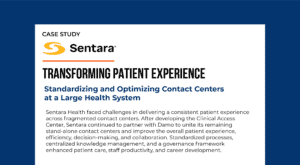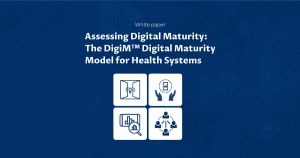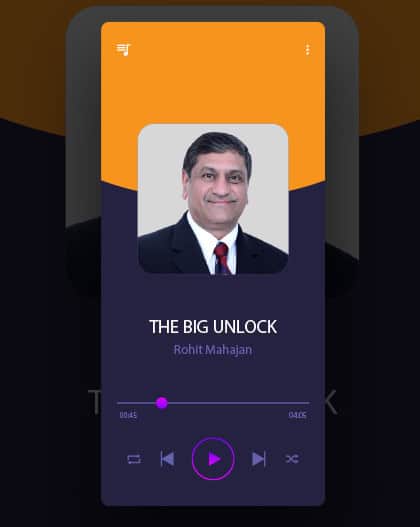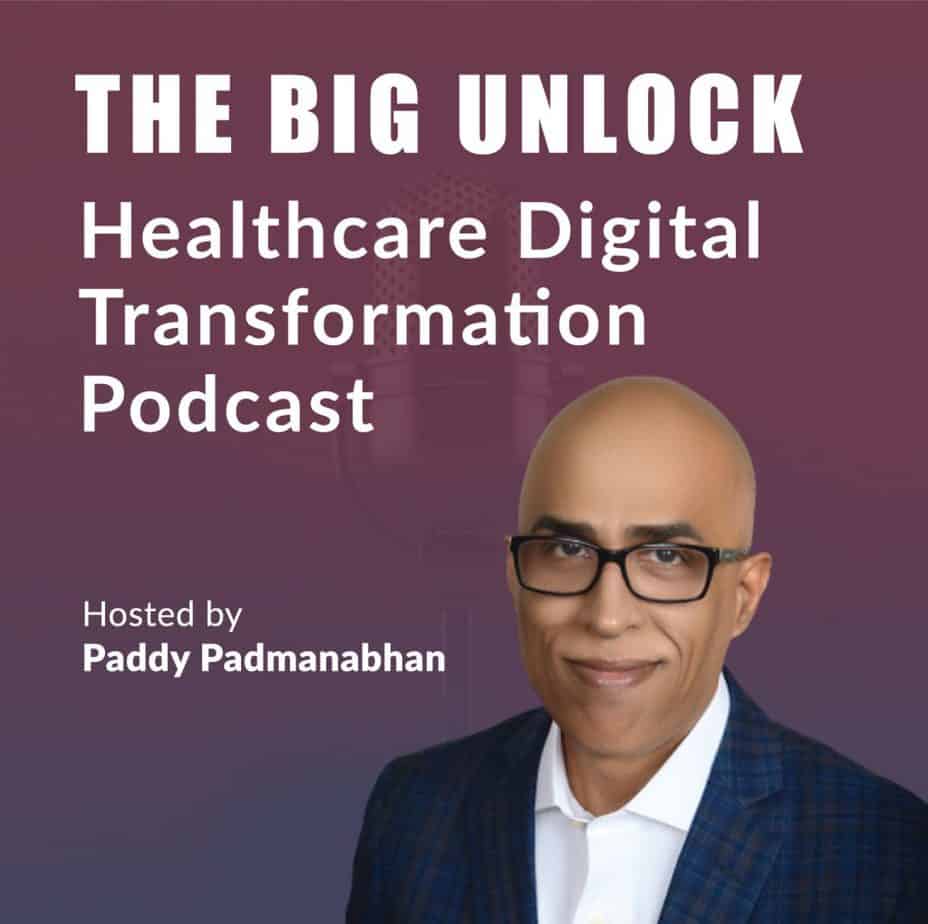Gimme Five: An Interview with Paddy Padmanabhan on the State of Digital Transformation in Healthcare
Paddy Padmanabhan is a renowned entrepreneur, healthcare digital strategist, speaker, and podcaster. He is author of “The Big Unlock,” a healthcare technology guide to harnessing data and growing digital health business in a value-based care era.
Paddy sat down with AHEAD’s EVP of Customer Success and CMO Tom Pohlmann to discuss the state of digital transformation in healthcare and how large health systems are leading their change initiatives.
Summary Takeaways:
- Patient engagement and competitive pressures from elsewhere in the healthcare ecosystem are the primary drivers of transformation.
- One of the biggest challenges related to healthcare transformation is to avoid overwhelming or burning out caregivers. The industry can learn from the decade of EMR transformation.
- The largest health systems are setting the pace in establishing a Chief Digital Officer role separate from the traditional CIO. Both roles are vital to successful transformations.
- The CIO should own the core infrastructure, operations, and applications elements on which the advanced technologies can make their promised impact.
- Whether a transformation office is in place or not, someone must coordinate the multiple stakeholders for transformation to succeed. Roadmaps are key.
The Interview:
Tom: How would you characterize the state of digital transformation in healthcare today?
Paddy: I would say healthcare is behind some industries and ahead of others. It’s behind industries like banking, financial services, hospitality, and e-commerce—especially as it pertains to digitally transforming customer engagement. But healthcare is much further ahead of other industries.
What stands out about our large health systems is that they acknowledge the need to truly transform patient engagement. That recognition is driving a degree of urgency across all of healthcare, which is very encouraging to see.
What’s driving that growing obsession with patient engagement? Is it a matter of competitive pressure?
There are a few factors converging here, compelling healthcare organizations to act. First, there’s healthcare consumerism. Consumers are used to engaging digitally with businesses in most aspects of their life, whether that’s banking, shopping online, entertainment and so on. There’s a natural tendency to look for similar experiences with their healthcare providers.
There’s also a demographic aspect to it. Younger consumers are digital natives. They want what they need, when they want it, all delivered via smartphone. As their health needs change or increase, they’ll expect the same from doctors or other caregivers.
The other driver is indeed competitive pressure. Non-traditional players are entering healthcare today from other parts of the healthcare ecosystem – like a CVS or Walgreens. Or they’re from outside healthcare – someone like Amazon or Apple. These entrants put pressure on traditional healthcare to up its game as it relates to serving patients – not just treating them.
As we all know, digital transformation is about much more than technology. How do you see the scope of transformation?
You’re right, digital transformation is not about technology. Digital isn’t an IT project, or at the very least, it’s not just an IT project. Digital involves reimagining the way your business model exists today and reimagining the relationship with your primary audience through technology. In this regard, technology is at the heart of it because technology makes those reimagined experiences a reality.
There’s also a culture change in the recognition that “business as usual” can’t continue. There truly is a need to change the approach towards engaging with primary stakeholders – not just the patients I mentioned earlier, but the caregivers. Health systems are wrestling with how to enable caregivers to deliver outstanding care through technology without overwhelming them and burning them out.
Could you expand on the caregiver’s perspective? Are caregivers clamoring for more digital capabilities or are they more passive recipients of change?
In the last ten years healthcare in the United States has been through one of the biggest digital transformations you can think of in any sector across the globe. We implemented electronic health records and digitized patient medical records over a period of ten years, starting with the HITECH Act and the Affordable Care Act, and now we have near-total penetration of electronic health records.
That was a massive transformation, but it was painful for caregivers because the drivers of transformation were largely financial, and it was mandated. A lot of the technology solutions that were implemented did not take into consideration the additional burdens being imposed on physicians, which created a lot of burnout and pushback from the physician community.
Now the focus has shifted to reducing the burdens on physicians and allowing them to focus more on taking care of their patients. Any technology solution that is put in place must consider whether it is going to increase or decrease the burden on the caregiver. So, in a lot of ways digital transformation is also about helping caregivers become more productive and efficient while continuing to deliver outstanding care to patients on their own terms.
How are health systems approaching the leadership and oversight of their transformation efforts?
Healthcare’s models for how transformations are run are evolving. I see multiple models if I look across the landscape of leading health systems in the country, including the ones that my firm has worked with and I personally work with.
You have one approach where digital transformation is led by a chief digital officer whose role is separate from the chief information officer. They work very closely with another, but their mandates are different, and they operate independently. In some cases, that digital role is combined with a chief innovation office role, but again separate from traditional IT. One of these variants seems to be the preferred approach among the top 25 health systems.
Outside of those top health systems, the most dominant model is where the CIO also assumes responsibility for digital. But the top 25 will guide where things evolve. We’ll see these roles separated and run by different individuals and increasingly, we’ll see the chief digital officer roles filled by people from industries that are more digitally mature.
I’ve always heard that healthcare can be insular. In those top 25 healthcare systems—where are CEOs looking to find their chief digital officers?
A lot of those roles are being filled from the retail, e-commerce, or banking — industries ahead of healthcare when it comes to digital strategy. I’m certainly seeing a trend over the past 12 to 18 months of non-healthcare executives coming into healthcare specifically for digital leadership roles. But in those cases, healthcare experience, or even clinical experience, is vital at the next layer of management down.
What are you seeing in terms of how large healthcare systems oversee transformation? Do they set up digital transformation offices?
I’m working with a client right now who has done exactly that—which is to set up a digital transformation office with a dedicated leader in a newly created position. There is certainly a recognition that the transformation office has an important role to play in coordinating multiple efforts across the organization and providing common governance and structure. This role helps to coordinate transformation initiatives and provide an enterprise-wide view while making sure all groups make progress and deliver on the mandate.
While some organizations have formal transformation offices, others operate in that fashion in a de facto mode. Some leaders just naturally excel at bringing together a diverse set of stakeholders in order to execute the transformation. In effect, they operate as a transformation office in all but name. The approach is cross-functional in nature and requires a significant amount of cross-functional stakeholder management in order to move projects along.
So, in those cases where there’s a separate CIO and a Chief Digital Officer, how do you see the two roles working together?
More than not, I’m seeing a very close relationship between the CIO and Chief Digital Officer in the organizations with whom I work. The fact is that digital requires the all-in support of the CIO because you need to have a robust infrastructure, operations, and applications layer to be able to execute on those emerging or advanced technologies that drive healthcare forward.
Whether it’s data infrastructure, robust integration, or cloud strategy, these are all IT foundational elements under the purview of the CIO. The CIO must be involved to make sure this core is in place, that they are modernized appropriately and budgeted for.
Also, CIOs have valuable experience in managing technology vendors, and that’s an important component of success—picking the right partners.
How do you see health systems managing the innovate-operate paradox? That is, having to innovate to the benefit of patients, all while delivering savings?
I don’t believe there is a paradox. It’s not an either-or situation. Chief digital officers recognize there is an important role for the core IT functions to play – to operate optimally in order for the hospital to innovate.
For instance, if you look at innovation programs that are developing applications to address a specific patient need. These applications are built using polished front-end tools, but behind the scenes, there’s an elaborate and complex orchestration of data management, API services, advanced analytics and so on, all of which are necessary for these new experiences to be successful.
If you take something like an API services strategy, it’s about how you can make your developers more productive, how you can accelerate innovation and bring your products to market faster, efficiently, and at scale. API services management may not sound like innovation but it’s just as important a part of innovation as that slick mobile interface.
Last question, Paddy. What advice would you give to that healthcare Chief Digital Officer who is in the throes of a complex transformation?
Align all stakeholders with a single roadmap. Roadmap alignment is key to gaining support from your stakeholders, but also as a vehicle to communicate how their needs are also being met. The roadmap must be the meeting point.
Also, keep in mind there’s a lot of risk involved in being a chief digital officer. You’re trying to transform the patient experience, but there is no beaten path to follow. You’re inventing new things and hoping patients (or clinicians) respond positively, but some of these initiatives will fail. Yes, there’s a “fail fast and move on” mindset when it comes to digital, but in healthcare especially, if you bet wrong on technologies – or untested, unproven startups – the fallout can be severe. In healthcare especially, one must approach transformation with a risk mitigation mindset.
Originally published on AHEAD.

